Publié sur :
Power point Nicole Delépine - 2002
Voir la version PDF de cette publication :

Adverse effects of radiotherapy and chemotherapy on long term results of composite prosthesis-allograft in tumor surgery.
Delepine G. Delepine F. Hernigou P.
Nicole Delépine
Adverse effects of radiotherapy and chemotherapy on long term results of composite prosthesis-allograft in tumor surgery.
Introduction
- In Creteil we implanted our first massive composite prosthesis allograft (MCP) in 1984.
- We hoped that MCP could permit a better muscle anchorage and that restoration of bone stock would decrease the loosening risk of prosthesis.
- The aims of this study is to precise the effect of adjuvant therapies on late results.
The allografts
All allografts of this study were provided by the bone bank of Creteil :
- Sterile harvesting
- Cryopreservation by -40°
- Irradiation before implantation (25 Kgray)
- Selection of graft on plain X rays without immunologic matching
- 3 months quarentaine before implantation
78 MCP followed up more than 12 years
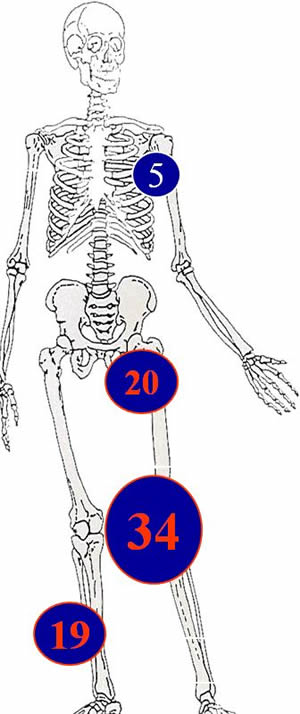
The locations were :
- 34 Distal Femur
- 20 Proximal Femur
- 19 Upper Tibia
- 5 Proximal Humerus
Method
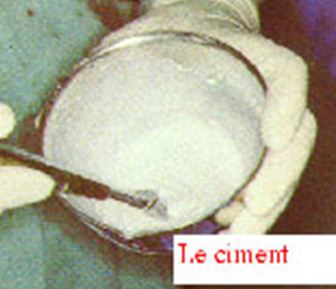
- Strong fixation of allograft on prosthesis (cement)
- Precise fitting of the allograft on the host bone (size selection and special tools)
- Autografting of the host-graft junction
- Good muscular coverage (flap)
34 Skeletal Reconstructions for distal femur with long term follow up
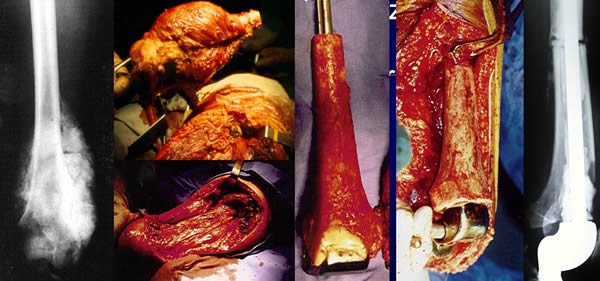
20 Skeletal Reconstructions for proximal femur with long term follow up
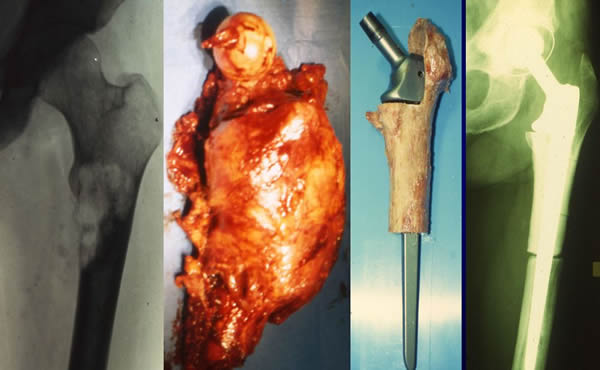
19 Skeletal reconstructions for proximal tibia with long term follow up
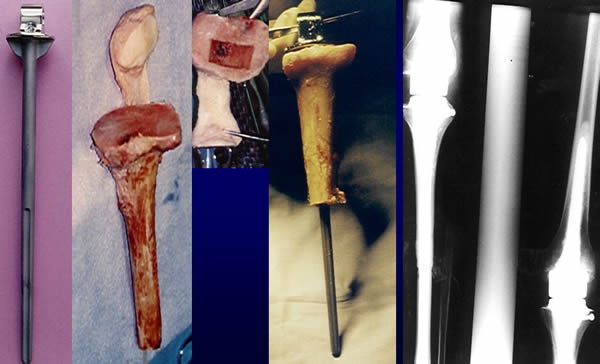
5 Reconstructions by prosthesis allograft with long follow up
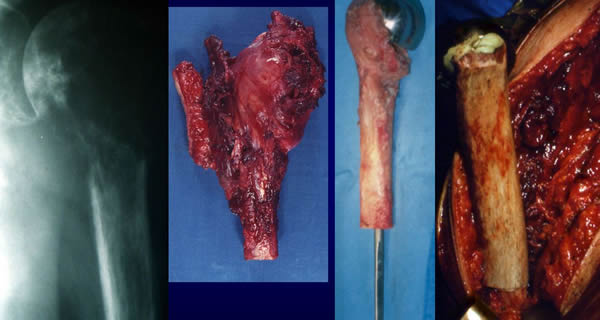
MFH treated by chemotherapy and en bloc resection.
78 patients 48 males and 30 females median age 17
The tumors were :
- osteosarcoma (46)
- Ewing's (10)
- Fibrosarcoma or MFH (10)
- chondrosarcoma (7)
- Other primary (5)
60 patients received chemotherapy and 21 chemotherapy and radiotherapy.
Bone healing is usual
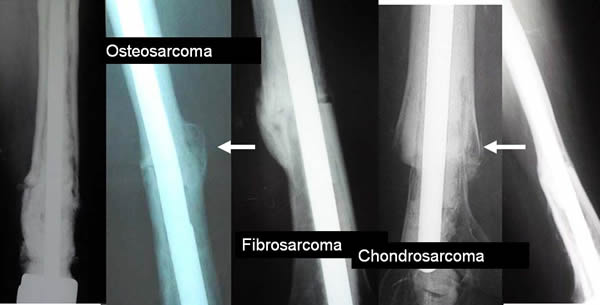
Time to bone healing hangs on quality of junction and type of adjuvant treatments : chemotherapy delays the bone union.
In case of association with radiotherapy the bone union is rare
NON UNION
(Persistance of radiolucent line at jonction)
- 16 / 78 (20%)
- Most of them on humeral prosthesis
- Without significant auto grafting
-In patients with chemotherapy and /or radiotherapy
Long Term Results
- With a median follow up of 19 years (12-24) all patients were reoperated for lengthening
- Wear of prosthesis
- Loosening
- Resorption of allograft
- Infection (21) or tumour recurrence (2)
Secondary Lengthening
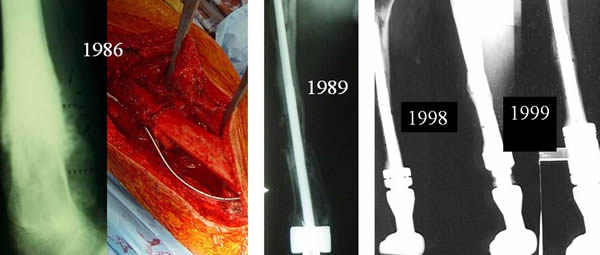
- The healing of the graft permits a longer anchorage for the stem of the expanding prosthesis.
- Secondary lengthening 8 centimeters.
Wear of prosthesis and bone resorption
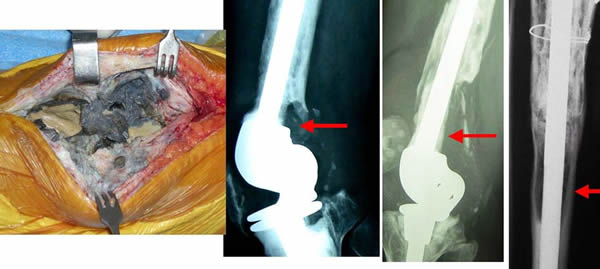
Liberation of wear particules sometimes induced a bone resorption near the articulattion or distally around the stem.
Resorption of allograft in 51 patients
- 51 resorptions
- 25 minor
- 16 severe
- 10 major
The 21 irradiated patients suffered of :
15 non union
18 secondary fractures
8 secondary major resorptions
and 11 deep infections resulting in 6 amputations.
Complications are correlated with adjuvant therapies.
Minor RESORPTION
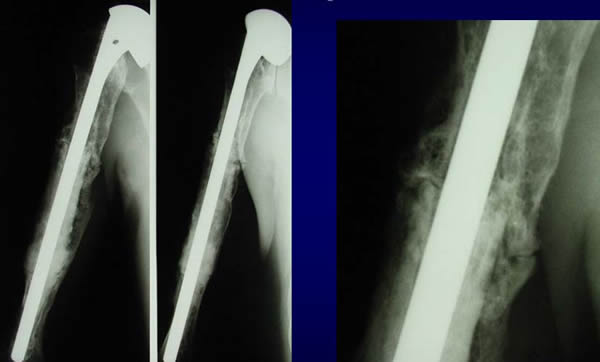
12 years follow up
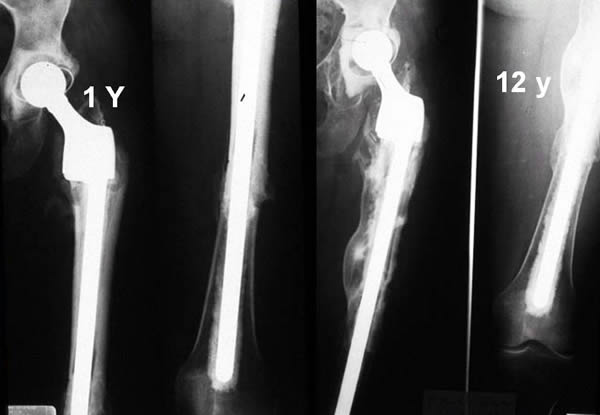
Chondrosarcoma. No adj.
17 Years follow up
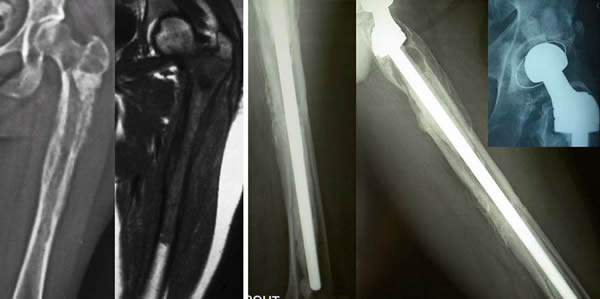
Chondrosarcoma no adjuvant therapy.
Wear of the acetabulum.
20 years evolution
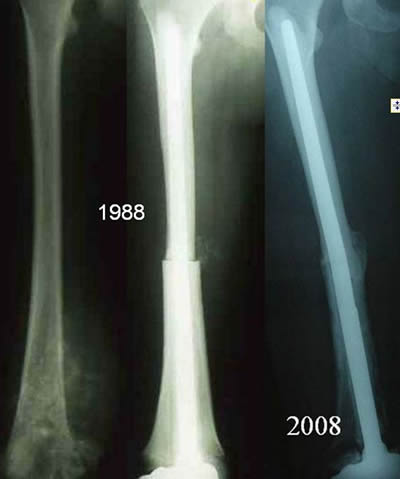
- High grade osteosarcoma
- High dose chemotherapy
- CDFS
- No radiotherapy
- Excellent graft evolution
- Excellent function
24 years follow up (no adjuvant treatment)
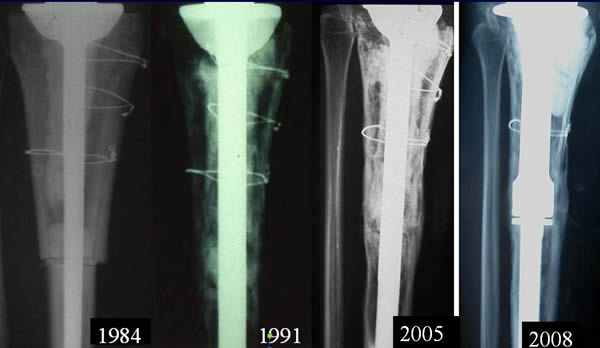
No severe nor major resorption observed despite 3 exchanges of knee prosthesis.
Fracture without loosening
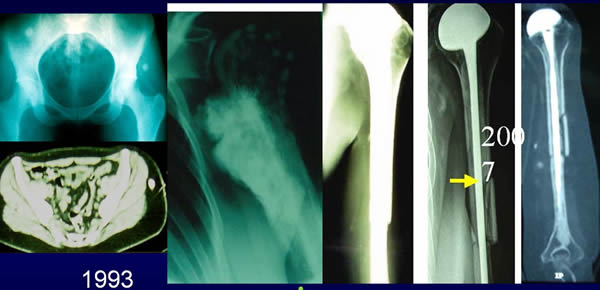
Metastatic Juxta cortical OS. No chemotherapy.15 years follow up Fracture of allograft without resorption nor loosening.
Chemotherapy, Resorption, Fracture of graft, Loosening
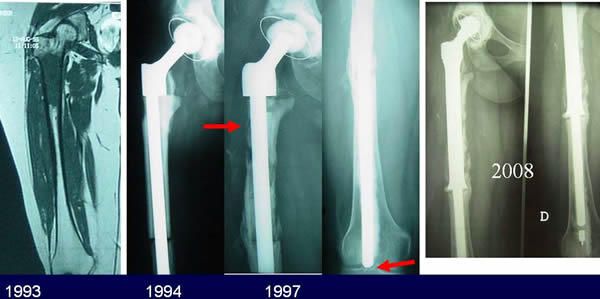
High grade OS High dose chemotherapy. Mal union and Resorption of graft induced loosening of prosthesis.
RADIOTHERAPY: non union, major resorption, fracture
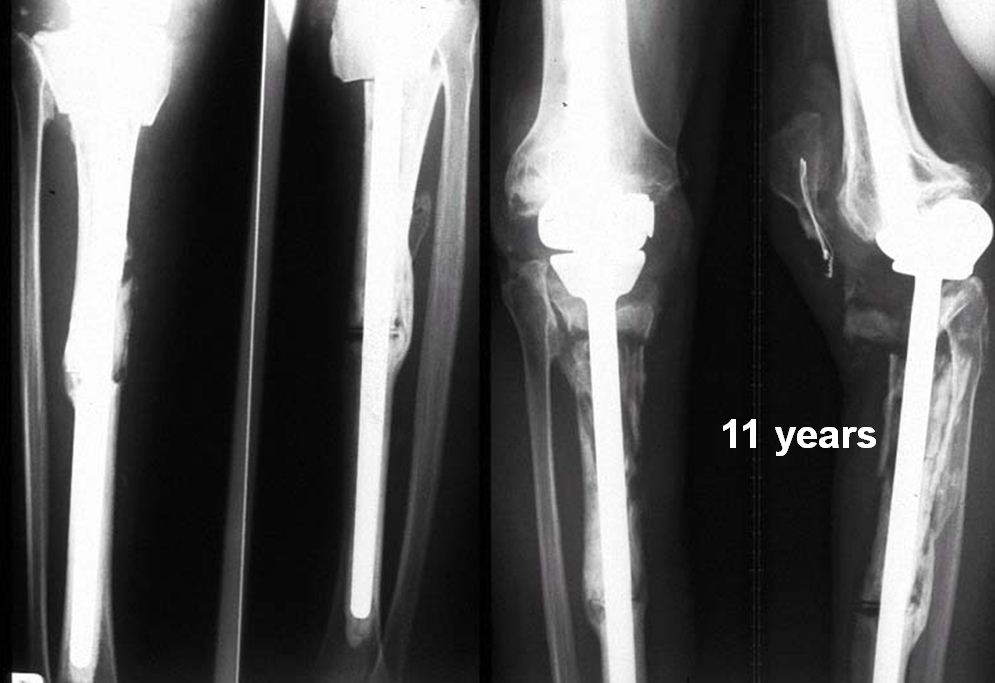
MAJOR RESORPTION
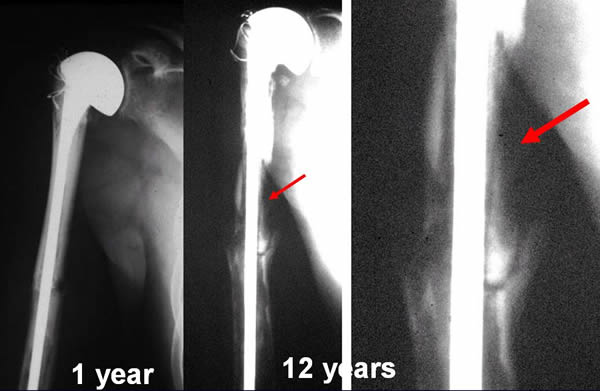
Failure of MCP after radiotherapy and chemotherapy
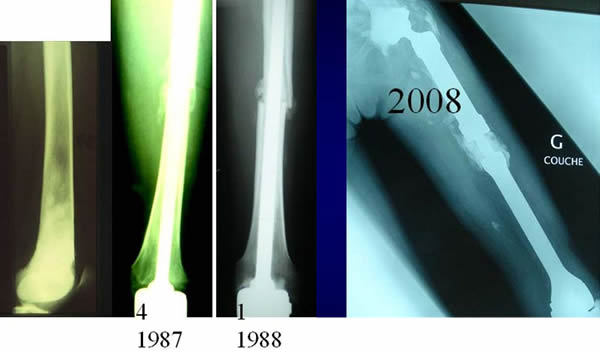
1°) OS with skip metastasis.Bad response to CHT. RTH 45 Gys.
2°) Fracture of allograft.
- Loosening of prosthesis.
- Total femur resection.
Late results
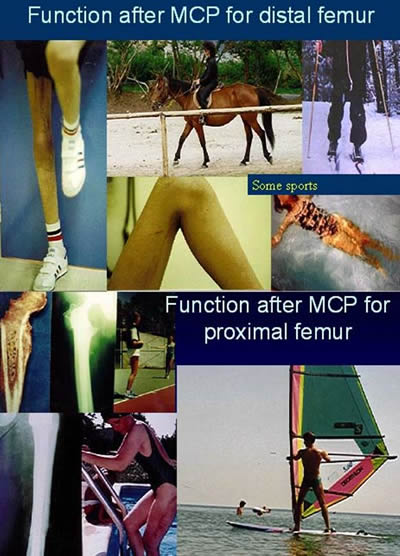
EMSOS criteria rated:
- excellent in 31
- good in 23
- fair in 12
- poor in 12
Advantages of MCP
- MCP permits a better muscle re insertion and gives usually a better function than massive prosthesis.
- This advantage is more evident for upper femur and proximal tibia and humerus.
- With long follow up the loosening risk of MCP does not seem different from that of massive metallic prosthesis except when a very long resection is necessary.
19 years follow up
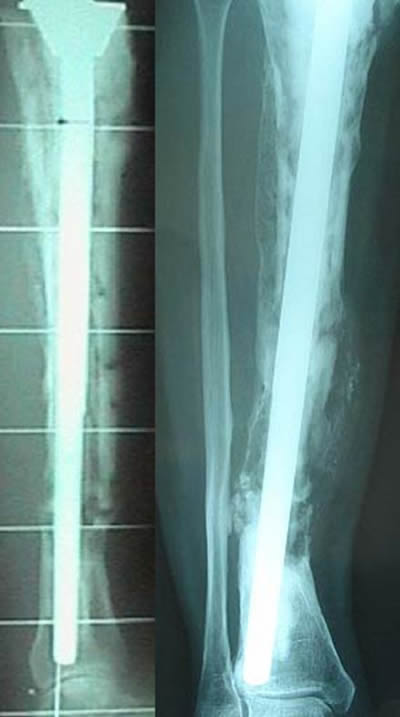
- 1989 :Ewing's sarcoma with resection of 4/5 tibia.
- Osteolysis of graft and wear of prosthesis but no loosening.
Conclusion
- MCP are threatened by non union during chemotherapy and massive osteolysis and fracture after irradiation.
- When radiotherapy can not be avoided a massive custom made prosthesis should be preferred to MCP.


